
Catwoman is a fictional character created by Bill Finger and Bob Kane who appears in American comic books published by DC Comics, commonly in association with the superhero Batman. Debuting as "the Cat" in Batman #1, she is one of the Dark Knight's most notable enemies and belongs to the collective of adversaries that make up his rogues' gallery. However, the character has also been depicted as an antiheroine and become Batman's best known and most enduring love interest, with many stories depicting their complex love–hate relationship. Since 1993, Catwoman has had her own ongoing series, Catwoman.

James Worthington "Jim" Gordon, Sr. is a fictional character appearing in American comic books published by DC Comics, most commonly in association with the superhero Batman. Created by Bill Finger and Bob Kane as an ally of Batman, the character debuted in the first panel of Detective Comics #27, Batman's first appearance, making him the first Batman supporting character ever to be introduced, eventually succeeding him as Batman from 2015 to 2016.
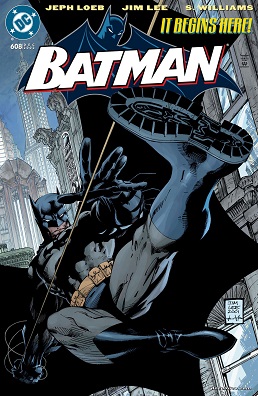
Batman: Hush is an American comic book story arc published by DC Comics featuring the superhero Batman. It was published in monthly installments within the comic book series Batman, running from issue #608–619 in October 2002 until September 2003. The story arc was written by Jeph Loeb, penciled by Jim Lee, inked by Scott Williams, and colored by Alex Sinclair, under the editorship of Bob Schreck.
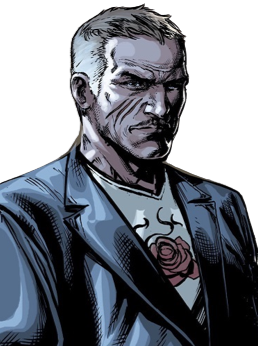
Carmine Falcone is a fictional character in DC Comics, portrayed as a powerful mob boss, an enemy of Batman, and a friend of the Wayne family. He has also been depicted in some versions as the illegitimate father of Catwoman.
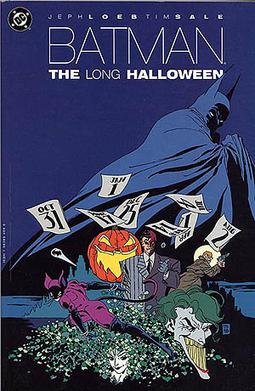
Batman: The Long Halloween is a 13-issue American comic book limited series written by Jeph Loeb with art by Tim Sale. It was originally published by DC Comics in 1996 and 1997. It was the follow-up to three Batman: Legends of the Dark Knight Halloween Specials by the same creative team. The series' success led to Loeb and Sale to reteam for two sequels, Batman: Dark Victory and Catwoman: When in Rome, which are set concurrently.

Batman: Dark Victory is a 14-part American comic book limited series published by DC Comics, featuring the superhero Batman. The series, which ran from 1999 until 2000, was written by Jeph Loeb and drawn by Tim Sale, and it serves as a sequel to Batman: The Long Halloween. Batman: Dark Victory takes place primarily four to five years into Batman's career as a vigilante crimefighter. The plot centers on a series of murders involving Gotham City police officers by a mysterious serial killer only known as the Hangman. Central to the storyline is a territory war between Two-Face and the remnants of the Falcone mob, led by Sofia Falcone.

Gotham by Gaslight is a DC Comics one-shot by Brian Augustyn and Mike Mignola, with inks by P. Craig Russell. The story revolves around a 19th-century version of Bruce Wayne making his debut as Batman just as Jack the Ripper has arrived in Gotham City.
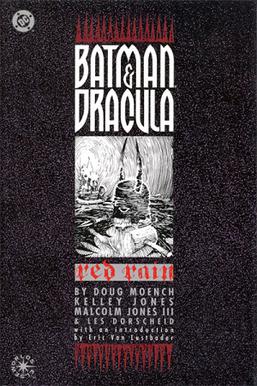
The Batman & Dracula trilogy consists of three American graphic novels—Batman & Dracula: Red Rain (1991), Bloodstorm (1994), and Crimson Mist (1998)—written by Doug Moench and penciled by Kelley Jones. The books were published by DC Comics as a part of its Elseworlds line of comics. Moench created the concept for the first installment and convinced Jones, of whom he was a fan, to join the project. Red Rain's eventual popularity resulted in DC commissioning sequels.
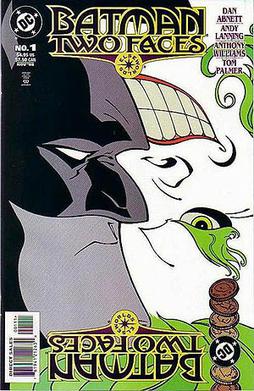
Batman: Two Faces is a DC Comics Elseworlds comic book, published in 1998. Written by Dan Abnett and Andy Lanning, with art by Anthony Williams and Tom Palmer, the story is based on the novel Strange Case of Dr. Jekyll and Mr. Hyde by Robert Louis Stevenson. A Victorian-era Bruce Wayne tries to purge both his own evil side and that of Two-Face, while a serial killer named the Joker roams the streets. A sequel, The Superman Monster, was published in October the following year.
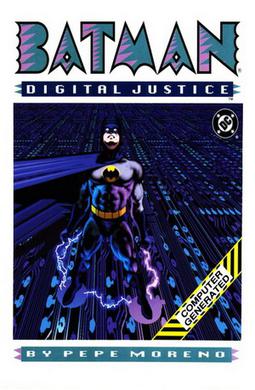
Batman: Digital Justice is a graphic novel published by DC Comics in 1990 in both hardback and paperback forms. It was written and illustrated by Pepe Moreno entirely using computer hardware, software and techniques. The story takes place outside regular DC continuity, but is not an Elseworlds title.

Batman: Earth One is a series of graphic novels written by Geoff Johns and illustrated by Gary Frank. The series is a modernized re-imagining of DC Comics' long-running Batman comic book franchise as part of the company's Earth One imprint. Earth One's Batman exists alongside other revamped DC characters in Earth One titles, including Superman: Earth One and Wonder Woman: Earth One, as well as other graphic novels.
As a fictional character and the archenemy of Batman, the Joker has been represented in a variety of different stories that redefine elements of the character's appearance and personality. Each work typically establishes its own continuity, and sometimes introduces parallel universes, to the point where distinct differences in the portrayal of the character can be identified. This article details various versions of the Joker depicted in works including alternative universe stories.

Batman: Gotham Noir is an Elseworlds graphic novel published by DC Comics in 2001, written by Ed Brubaker, with art by Sean Phillips.
Batman: The Dark Prince Charming is an original two-volume graphic novel series from American comic book publisher DC Comics and French publisher Dargaud, featuring the DC Universe character Batman. The first volume was released on November 1, 2017, followed by the second volume on June 20, 2018. It was written, illustrated, and painted by Italian artist Enrico Marini and is his first major American publication. In The Dark Prince Charming, Batman pursues the Joker and Harley Quinn, who have kidnapped a child whose mother claims her to be the daughter of Bruce Wayne. The series is considered a standalone, out-of-continuity story.

Selina Kyle, nicknamed "Cat", is a fictional character on the Fox TV series Gotham. Based on the DC Comics character of the same name who goes on to become Catwoman, Selina is a morally ambiguous street thief who becomes an ally and later love interest to Bruce Wayne, the orphaned son of Thomas and Martha Wayne. Camren Bicondova portrays Selina Kyle for the majority of Gotham's run, but is replaced by Lili Simmons as an adult in the series finale.

"The Beginning..." is the series finale of the American television series Gotham, based on the DC Comics characters Jim Gordon and Bruce Wayne. It is the twelfth episode of the fifth season and the 100th overall episode of the series. The episode was written by showrunner John Stephens and directed by Rob Bailey.
The fictional character Two-Face was created by Bob Kane and Bill Finger and first appeared in Detective Comics #66. However, the character in his disfigured state was not portrayed by an actor until half a century later in Batman: The Animated Series. Two-Face has since been substantially adapted from the comics into various forms of media, such as feature films, television series and video games. Two-Face has been voiced by Richard Moll in the DC animated universe, Troy Baker in the Batman: Arkham series, Billy Dee Williams in The Lego Batman Movie, and William Shatner in Batman vs. Two-Face. His live-action portrayals include Billy Dee Williams in Batman, Tommy Lee Jones in Batman Forever, Aaron Eckhart in The Dark Knight, and Nicholas D'Agosto in the television series Gotham. In 2009, Two-Face was ranked #12 on IGN's list of the Top 100 Comic Book Villains of All Time.
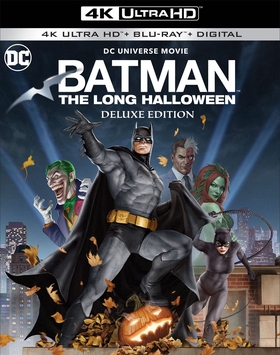
Batman: The Long Halloween is a 2021 American two-part animated direct-to-video superhero film produced by Warner Bros. Animation and DC Entertainment, based on the DC Comics storyline of the same name. Part 1 is the 44th film, and Part 2 is the 45th film, of the DC Universe Animated Original Movies, with both parts serving as the third and fourth installments of the Tomorrowverse. The film is directed by Chris Palmer and stars the voices of Jensen Ackles, Naya Rivera, Josh Duhamel, Billy Burke, Titus Welliver, David Dastmalchian, Troy Baker, Amy Landecker, Julie Nathanson, Jack Quaid, Fred Tatasciore and Alastair Duncan. The film is dedicated to Rivera, as it was her final film role before her death in 2020. In both parts of the film, Batman attempts to unravel the mystery of murders committed on holidays throughout the year, and uncover the true identity of the serial killer Holiday.














